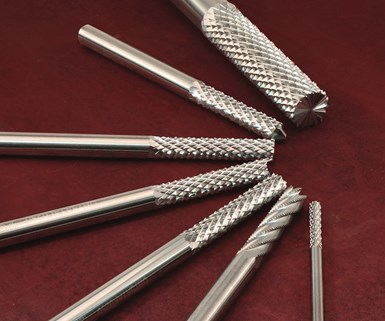YG-1's Fiberglass Routers Designed for Manual, CNC Cutting
YG-1 offers a series of four solid carbide fiberglass routers designed to handle machining of fiberglass and other high-performance fibers.
Share






YG-1 offers a series of four solid carbide fiberglass routers designed to handle machining of fiberglass and other high-performance fibers. These new routers are said to be optimized in composition, cutting angles, flute strength and stability for longer life and lower cost per part. Four different cutting ends make these fiberglass/composites routers ideal for roughing, finishing, edge trimming, slotting, grooving, drilling or interpolation, achieving the same quality results on a CNC machining center or hand routing, the company says.
The Type I (NC end) is mostly for side milling, roughing or finishing passes to achieve a high-quality finish. Type II (burr end) is designed for plunging without damaging side flutes. Type III (mill end) is best for surface milling molds or grooving with surface finish requirements. Type IV (drill end) can be used as a router and a drill and is designed for interpolation to achieve final hole diameter or slotting with a corner radius.
More applications include machining in carbon fiber, Kevlar and other aramid blends, natural fiber-based composites and thermoset resin/thermoplastic blends.
The tools’ double-angle point geometry is designed to counteract or eliminate the machining problems typically encountered with carbon fiber reinforced plastic (CFRP) characteristics. The CVD coating increases abrasion resistance from the fibrous materials and extends tool life. Combined with guidance margins and open flutes, these specialized routers also drill holes with no dust jams or pressure overload, the company says. Suited to manual hole-making, countersinks and counterbores, hand drilling reduces delamination and fiber pullout.
Related Content
-
How to Troubleshoot Issues With Tool Life
Diagnosing when a tool is failing is important because it sets an expectation and a benchmark for improvements. Finding out why gives us a clue for how to fix it.
-
Quick-Change Tool Heads Reduce Setup on Swiss-Type Turning Centers
This new quick-change tooling system enables shops to get more production from their Swiss turning centers through reduced tool setup time and matches the performance of a solid tool.
-
How to Accelerate Robotic Deburring & Automated Material Removal
Pairing automation with air-driven motors that push cutting tool speeds up to 65,000 RPM with no duty cycle can dramatically improve throughput and improve finishing.













.jpg;maxWidth=300;quality=90)






